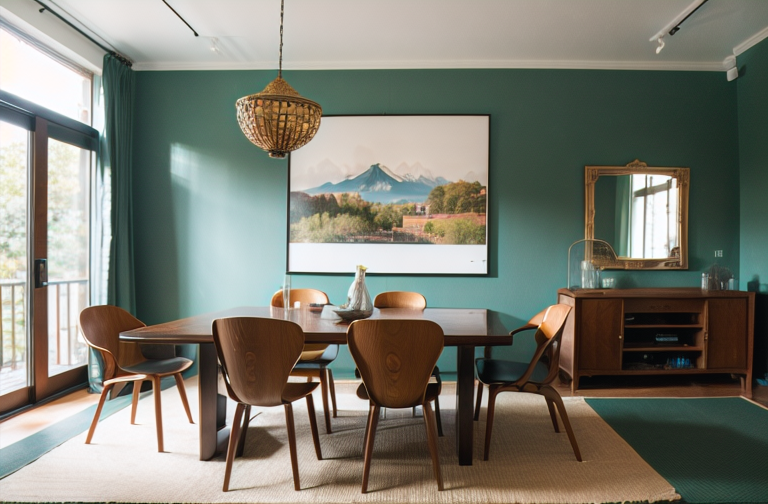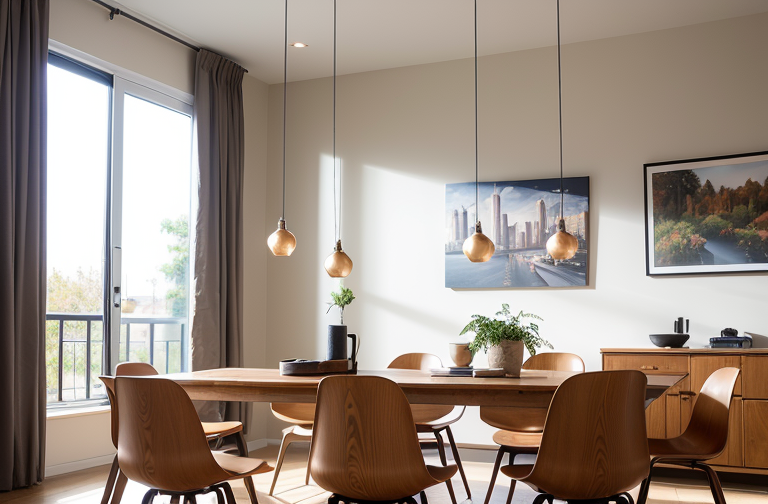
Explore different design styles including Art Deco, Bohemian, and Coastal, and design elements like natural materials and asymmetry. Learn how to use technology and color in decor.
Defining Interior Design Styles
To better understand the different types of house interior design, let’s delve into the enchanting world of varying aesthetics and arrangements. Each style, be it Art Deco, Bohemian, Coastal, Contemporary, Country, or Eclectic, sings a different verse in the melody of design, yet together they create a harmonious symphony.
Art Deco Style
Ah, Art Deco, born in the glamorous Paris of the 1920s. This style distills the essence of quality craftsmanship and indulges in unapologetic luxury, marking a celebration of elevated standards and details that don’t just speak but croon elegance. 🍾
Bohemian Style
Drifting towards Bohemian style, the design frees itself from traditional constraints. An ode to the nomadic French bohemians, this style delights in breaking the mold, making room for eclectic creativity and unabashed rule breaking. This design philosophy won’t be pigeonholed—it’s a celebration of personal expression and defining your own standards.🖼️
Coastal Style
Coastal style, like a breath of fresh air, brings the serene seaside right into your abode. Its inspiration emerges from natural elements, reminiscent of luxury oceanside homes. Predominantly adorned in shades of white and blue, the coastal style soothes your senses and casts a calming spell on the space.🌊
Contemporary Style
Highlighting the fluidity of design, Contemporary style is as current as it gets. Born in the 1970s, this style adapts and blends the latest trends and silhouettes, standing as a testament to the exciting evolution of design. It’s constantly defining and redefining what it means to be ’in vogue’.
Cottage/Country Style
Contrasting the Contemporary style, the Cottage/Country style harkens back to simpler times. It reflects rural idylls and taps into the appeal of a less complicated lifestyle. Quintessential antique furniture and classic patterns characterize this design persona, bringing a sense of homely warmth to the space.
Eclectic Style
The Eclectic style, a trendsetting relic from 19th century Paris. It’s a masterful mix of various other styles, showcasing the beauty of artistic balance in apparent chaos. Each element tells its own story, perfectly clashing and cooperating with the others.🎭
In the realm of interior design, styles are far more than aesthetic choices—they’re reflections of personalities, histories, and individual journeys. Thus, the beauty of these styles lie not just in their visual appeal but in their narratives.

Emphasis on Natural Elements
As an interior design enthusiast, my affinity for embracing the beauty of nature in house design interior is fundamental. Organic elements and textures transport life force into our domestic spaces, making each corner bristle and breathe with vitality.
Connection of Natural Elements in Different Styles
Craftsman, bohemian, and coastal design styles all lean heavily towards natural materials and elements. The secret is the fusion of form and function in harmony. Each piece of raw wood, each threadbare rugs, tells a tale of the earth, whispering sagely secrets into your space.
Advantages of Using Natural Elements
The inclusion of organic components in interior design prompts a plethora of advantages. Foremost among these is the calming, grounding environment it engenders, evoking an inherent feeling of tranquility. Imagine curling up on a comfortable sofa, draped with a tactile throw, amidst a room filled with the mellow warmth of natural wood furniture. This can be the sanctuary created by the careful selection and positioning of nuanced, natural elements.
Examples of Natural Elements in Design
Extending from wood to stone, natural elements are abound in thoughtful design. Stone, in its various forms, celebrates solidity and permanence. Meanwhile, natural textiles evoke barefoot walks along beach fronts and whispered conversations in sun kissed fields. Live plants, the undoubted champions of organic design, introduce a literal breath of fresh air into your space. These elements, each integral and transformative in their unique ways, foster a beautifully nuanced and powerfully evocative environment.
Emphasizing natural elements in interior design is more than aesthetic choice, it’s an interplay of emotional resonance and spatial perception. It’s the intangible comfort of knowing that you’re connected, in some small way, to the world outside your window.
Importance of Asymmetry and Flow in Design
Symphony in visual chaos, that’s the magic brought by asymmetry in interior design. Often, we think harmony is achieved only by balance, yet a more dynamic effect can be achieved with asymmetry—I have seen this in the different styles of houses interior design I’ve had the pleasure to work on.
Definition of Asymmetry in Design
Asymmetry, simply stated, is the absence of symmetry. In our spaces, it might mean an art piece hung slightly off center above a fireplace, or a cluster of mismatched chairs around a table. It evokes a sense of informality, of an artful disruption to behold.
Importance of Flow Between Spaces
Flow, on the other hand, is an essential player in connecting spaces. It harmonizes different areas in a way that lets the energy of the house move smoothly between indoor and outdoor spaces, painting a seamless landscape for the dwellers.🍃
Use Cases of Asymmetry and Flow
In the world of design, the combination of asymmetry and flow can express a unique artistic language. Take, for example, a living room that flows effortlessly into a garden patio. The unobstructed view of the greenery outside, framed by asymmetrically placed furniture inside, unites both realms into a wholesome enclosure of dynamism and serenity.
Asymmetry need not intimidate; rather, it should be seen as an opportunity to create fluid design layouts that encapsulate the rhythm of life within our homes. Through the interplay of asymmetry and flow, design becomes not just functional, but also poetic. It becomes the silent melody of living that makes a house feel truly like a home.

Enhancing Existing Architecture vs Complete Remodel
Explore different house interior designs by understanding existing architecture and discovering how to enhance architectural quirks. Witness the significant impact on the overall design when these architectural features are thoughtfully incorporated, creating a cohesive and personalized living space.
Understanding Existing Architecture
Each space has its own essence, its own rhythm, and by understanding it, we can bring out extraordinary beauty. From the subtlety of a silhouette to the expressiveness of molding, every architectural instrument plays a role in shaping the symphony of the result. It’s more than just a house design ideas interior; it’s about creating a harmony that resonates with your space.
How to Enhance Existing Architectural Quirks
Do you have a peculiar window frame or an unusual fireplace? Embrace these quirks. Instead of covering them up, make them focal points. Add a vintage chair to that odd corner. Highlight that interesting archway with complementary paint color. These subtle enhancements will evolve your place into a studied masterpiece instead of a standard rendition.
Impact on the Overall Design when Enhancing Existing Architecture
Enhancing original attributes can have a transformative impact on your overall design. The previously unnoticed cornice might reflect an interesting shadow pattern that taps into a forgotten era. An old fireplace could become a fetching centerpiece with a bit of sprucing up. This evolution is not just about aesthetic value, it’s about telling your home’s unique story and turning your living space into a sanctuary.
In all aspects of interior design, remember one essential rule: intentionality. It’s what distinguishes the mundane from the awe inspiring, the ordinary from the extraordinary. Find the balance between what already exists and what can be added, mine the magic within the quirks, and watch the spirit of your space come alive.
Incorporation of Modern Aspects in Design
In my experience, various different types of house interior design are embracing modern trends. I find that technology is becoming an integral part of our lifestyles and as a result, it’s making its way into house design interiors. An effective method for achieving this is through seamless integration of everyday tech items within our living spaces. Smart devices, sleek screens, and wireless systems can be artfully incorporated into the overall design, ensuring they don’t disrupt the aesthetics but rather, are part of it.
Seamless Integration of Technology in Design
Melding technology with aesthetics is no easy feat; yet, once achieved, it can breathe a whole new life into spaces. Digital frames for showcasing artwork, strategic placements of screens or a well incorporated sound system – when executed well, these elements can enhance the functionality of a space without compromising on style.
Strategic Use of Bold Colors
Exploring different styles of houses interior design, bold colors often take center stage. I personally lean towards deploying bold colors like black; it serves as an elegant backdrop, especially for art or other decor elements. Contrary to popular belief, these bold shades can make a space feel more open and inviting, and not oppressive, as some players in the field assert.
Enhancement of Natural Light in a Space
Finally, no discussion about house design ideas interior can be complete without acknowledging the power of natural light. When a room is saturated with sunlight, the ambiance is unsurpassed. Design elements such as well placed mirrors or optimal window placements can massively enhance the natural light in a space, thereby uplift the overall atmosphere.
Adapting to the modern aspects in design, seamlessly blending technology within decor, creatively using bold colors, and harnessing the power of natural light are all contemporary luminaries in good modern interior design.
- Unlocking the Intricacies of Interior Design: Ranch-Style Homes and the Pursuit of Functionality
- Blending Tradition and Modernity: Exploring the Design of Nipa Hut and Trynagoal Tea House
- Enhancing Dining Experiences through Creative Interior Design and Rebranding in Burger Restaurants
- Mastering Home Renovation: The Crucial Roles of an Interior Designer and Effective Budget Management
- Understanding the Value of Interior Designers: Roles, Benefits, and Selection Process
- Exploring the Richness of Turkish Architecture and Interior Design through Adobe Stock and Pinterest
- Unveiling the Unique Characteristics and Design Elements of Ranch-Style Houses
- Embracing Openness and Personal Touch: The California Ranch House Interior Design Concept
- Embracing Warm Minimalism: The Rise of Brown Tones in Interior Design
- Enhancing Your New Home: Key Elements and Strategies in Interior Design
- Unveiling the Art of Luxury Interior Design: Exploration of Materials, Individual Style and Inspiration from Pinterest
- 13 Easy and Affordable Tips to Spruce Up Your Home Decor
- Exploring the Rich History and Distinctive Features of Tudor Architecture
- Exploring British Home Interiors: From Historical Evolution to Modern Adaptation
- Traversing the World of Interior Design: From Designer Profiles to DIY Ideas and Future-ready Furniture
- Contemporary Home Refinement: Leveraging Exposed Brick Design and Affordable, High-Quality Furnishings
- Exploring the Warmth and Charm of Modern Rustic Interior Design
- Enhancing Duplex and Triplex Interiors: An In-Depth Guide to Style, Lighting, and Effective Use of Space
- Creating Your Dream Bathroom: A Comprehensive Guide to Designs, Functionality, and Material Selection
- Creating Your Personal Spa: Insights into Modern Bathroom Design Trends



